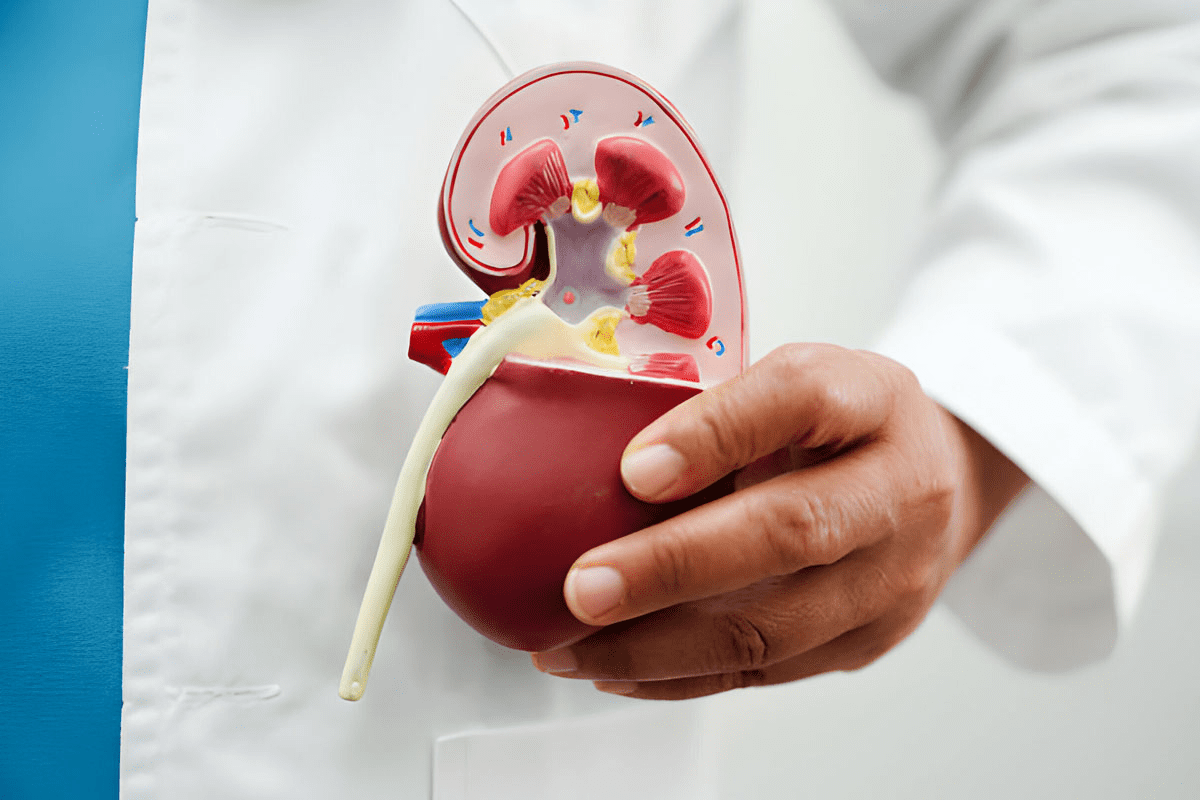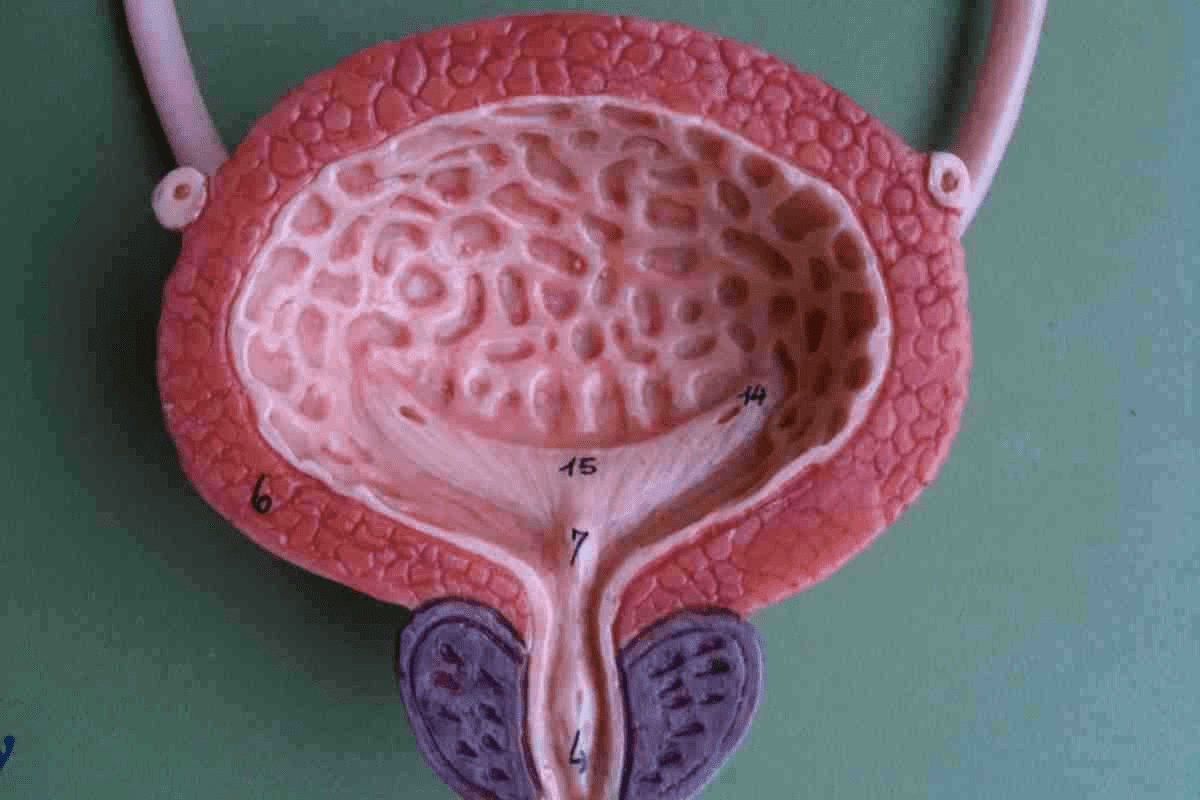Last Updated on November 6, 2025 by Bilal Hasdemir

Urinary health is key to our overall well-being. A condition that can harm it is bladder calculi, also known as cystolithiasis or vesical lithiasis. These stones form due to various reasons, with urinary stasis being a main cause. At Liv Hospital, we focus on this important urological issue that affects many people worldwide.
Learn how to prevent bladder calculi (bladder stones). Understand the different types and the underlying mechanisms of their formation.
Bladder stones are a common problem, making up about 5 percent of all urinary stones. If not treated, they can cause serious issues. We aim to help you understand the types, how they form, and how to prevent them. This way, you can take steps to keep your urinary system healthy.

Bladder calculi, or bladder stones, are solid formations in the urinary bladder. They can be made of calcium oxalate, uric acid, and struvite. These stones are a big deal in urology, causing pain and health issues.
Bladder calculi are hard mineral deposits in the bladder. The term cystolithiasis means having bladder stones. They can come from urinary stasis, infections, or foreign bodies in the bladder.
Knowing the terms for bladder calculi is key for correct diagnosis and treatment. Doctors use tools to find out what the stones are made of and how big they are. This helps decide how to treat them.
Bladder calculi are a worldwide health problem, affecting all ages. But some groups get them more often. The rate of bladder stones changes based on where you are and your diet.
Research shows bladder stones are more common where clean water and healthcare are scarce. In rich countries, bladder stones are rare. But they’re a big worry for the elderly and those with urological problems.

To understand bladder calculi, we must first know the urinary system’s anatomy and physiology. This system removes waste through urine. It includes the kidneys, ureters, bladder, and urethra, working together to filter blood and maintain balance.
Keeping the urinary system working right is key to our health. Any problems can lead to issues like bladder stones. Knowing how it works helps in preventing and managing bladder calculi.
The bladder stores urine and is made of muscle. It has layers like the mucosa and muscularis propria. The mucosa is the inner layer, lined with cells that protect against urine.
The muscularis propria layer has smooth muscle that helps push urine out. The bladder can stretch to hold more urine, allowing it to expand.
Urination is a team effort between the bladder and urethra. When the bladder is full, we feel the urge to go. The process involves relaxing the urethral sphincter and contracting the bladder muscle to let urine out.
Any problem in this process can cause urine to stay in the bladder. This can increase the risk of bladder stones. Knowing how urination works helps spot issues that might lead to stones.
Component | Function |
Kidneys | Filter blood, produce urine |
Ureters | Transport urine to the bladder |
Bladder | Stores urine |
Urethra | Expels urine from the body |
“The urinary system’s structure and function are linked to bladder calculi. Knowing this system is essential for prevention and management.”
It’s important to know why bladder stones form. They often come from a mix of things that cause urine to stay in the bladder too long.
Urinary stasis is the main reason for bladder stones. When urine stays in the bladder, it gets more concentrated. This can cause minerals to crystallize and form stones.
Factors contributing to urinary stasis include:
BPH is when the prostate gland gets bigger in older men. This can block urine flow. This blockage can cause urine to stay in the bladder, raising the risk of stones.
The connection between BPH and bladder stones is strong. The urine retention from BPH makes it easier for stones to form.
Neurogenic bladder is when someone has trouble controlling their bladder. This can be due to brain, spinal cord, or nerve issues. It can cause urine to stay in the bladder, raising the risk of stones.
Managing neurogenic bladder involves using medicines, making lifestyle changes, and sometimes surgery. These steps help improve bladder function and prevent stones.
Secondary risk factors play a big role in bladder stone formation. While we know the main causes, it’s important to look at these secondary factors too. They help us prevent and treat bladder stones better.
Urethral strictures make it hard for urine to flow. This can lead to minerals building up in the urine. This buildup increases the chance of bladder stones forming. Other issues like a diverticulum or bladder neck obstruction can also cause problems with urination, making stones more likely.
UTIs that keep coming back are a big risk for bladder stones. These infections can change the urine’s pH, making certain stones like struvite stones more likely. It’s key to manage UTIs well to avoid bladder stone problems.
Having things like catheters in the body can bring in bacteria. This can lead to infections and increase the risk of stones. These objects can also help stones form by providing a place for minerals to stick to.
Radiation therapy, when aimed at the pelvic area, can harm the bladder and tissues around it. This can change how the bladder works and raise the risk of stones. Schistosomiasis, a parasitic infection, can also damage the bladder and increase the risk of stones, mainly in areas where it’s common.
Risk Factor | Description | Impact on Bladder Stone Formation |
Urethral Strictures | Narrowing of the urethra | Increases urinary stasis, elevating stone risk |
Recurrent UTIs | Frequent infections | Alters urinary environment, promoting stone formation |
Foreign Bodies | Presence of objects like catheters | Introduces infection risk and provides a nidus for stones |
Radiation Therapy | Damage from radiation | Can cause bladder dysfunction and increase stone risk |
Schistosomiasis | Parasitic infection | Causes bladder damage, increasing stone risk |
It’s vital to understand these secondary risk factors to prevent and manage bladder stones. By tackling these factors, doctors can create better treatment plans for each patient.
It’s important to know about the different types of bladder stones. This knowledge helps in finding the right treatment and ways to prevent them. The type of stone matters a lot in deciding how to manage it.
Calcium oxalate stones are the most common, making up 75-90% of cases. They form when there’s too much oxalate in the urine or not enough calcium. Eating foods high in oxalate can also lead to their formation.
Uric acid stones are found in 5-20% of cases. They’re linked to conditions like gout or certain diets. To prevent them, managing uric acid levels is key.
Calcium phosphate stones make up 6-13% of bladder stones. They’re often seen in people with certain metabolic issues or pH problems in the urine. For example, renal tubular acidosis can raise the risk.
Struvite stones, or infection stones, are 2-15% of cases. They’re linked to urinary tract infections (UTIs) caused by certain bacteria. These stones can grow fast and fill the bladder.
Knowing what kind of stone you have is key to treating and preventing it. Doctors can suggest specific diets, medications, or other treatments based on the stone type. This helps manage and prevent future problems.
Bladder stone formation starts with crystallization. Knowing these stages helps in preventing and treating stones.
Minerals in urine crystallize first. This happens when their concentration is too high. Nucleation is when these crystals form a nucleus.
After a nucleus forms, the stone grows. This growth depends on many factors. These include urinary pH and the presence of infection or inflammation.
Factor | Influence on Stone Growth |
Urinary pH | Affects the solubility of minerals, influencing crystallization |
Infection/Inflammation | Can increase the concentration of certain substances, promoting stone growth |
Presence of Inhibitors | Can slow or prevent stone growth by inhibiting crystallization |
Bladder stones can form in two ways. They can form directly in the bladder or as a result of other conditions. Knowing this helps in choosing the right treatment.
Primary stones come from bladder issues. Secondary stones are linked to other health problems. Treating these problems is key to preventing more stones.
Symptoms of bladder calculi can vary, affecting how you urinate and causing discomfort. It’s important to recognize these signs early for timely medical care.
Pain is a key sign of bladder calculi. It can show up in the lower abdomen, pelvis, or even the groin. The pain’s strength can change, often getting worse when you urinate or move.
Pain Patterns Associated with Bladder Calculi:
Bladder calculi can alter your urinary habits. You might find yourself needing to urinate more often, feeling a sudden urge, or having trouble starting. You could also see blood in your urine or feel like your bladder isn’t emptying fully.
Urinary Change | Description |
Frequent Urination | Needing to urinate more often than usual |
Urgency | Sudden, intense need to urinate |
Dysuria | Pain or burning during urination |
Some symptoms need immediate medical help. These include severe pain, trouble urinating, or blood in your urine. If you see any of these signs, get medical help right away.
Warning Signs:
Spotting these symptoms early can help get a quick diagnosis and treatment. This can prevent serious problems from bladder calculi.
Healthcare providers use different methods to find bladder stones. These include physical exams, imaging studies, and lab tests. These steps help doctors find bladder stones and choose the right treatment.
A detailed physical exam is often the first step. Doctors might do a digital rectal examination (DRE). This helps check the prostate or rectum for problems that could cause urinary issues.
They also look for signs of urinary tract infections or other problems linked to bladder stones during the exam.
Imaging tests are key in finding bladder stones. The main imaging methods are:
Laboratory tests are vital for understanding bladder stone composition and finding the cause. These tests include:
By using physical exams, imaging, and lab tests together, doctors can accurately diagnose bladder stones. They then create a treatment plan that works.
Bladder calculi can be managed in different ways. The choice depends on the stone’s size, type, and how many there are. Your overall health also plays a big role in picking the best treatment.
For small stones or mild symptoms, non-surgical methods might be suggested. This could mean watchful waiting or making dietary changes. Drinking more water, eating less salt, and avoiding certain foods can help prevent stones from growing.
Medicines can also help manage symptoms or dissolve certain stones. For example, urinary alkalizers can dissolve uric acid stones. But, how well these treatments work depends on the stone type and your health.
For larger stones or severe symptoms, less invasive methods are often used. Cystolitholapaxy breaks down stones into smaller pieces that can be flushed out. This can be done with ultrasonic or laser lithotripsy.
Laser lithotripsy is great for breaking stones into tiny pieces. This method is less invasive and often leads to faster recovery times.
For very large stones, many stones, or stones with other bladder issues, surgery might be needed. Open surgery or cystotomy involves removing stones directly through an incision. This method is more invasive but can fix other bladder problems at the same time.
Some patients might have endoscopic procedures to remove stones without open surgery. These use a cystoscope to see and remove stones or break them down.
After treatment, it’s important to follow up to prevent stones from coming back. Patients are usually told to drink a lot of water and might get medicine to prevent infection or stones.
Follow-up appointments are key to check on recovery and watch for any new stones. Imaging tests might be done to make sure all stone pieces are gone and no new ones have formed.
Knowing what foods can lead to bladder stones is key to avoiding them. Bladder stones are hard mineral masses that form in the bladder. Diet greatly affects their formation. Making smart food choices can lower your risk of getting these stones.
The type of stone you might get affects your diet. For calcium oxalate stones, cut down on spinach and beets. If you’re at risk for uric acid stones, eat foods that make your urine less acidic.
Here are some general dietary recommendations based on stone type:
Stone Type | Dietary Recommendations |
Calcium Oxalate | Limit oxalate-rich foods; increase calcium intake through diet or supplements |
Uric Acid | Reduce purine intake; increase fluid intake to help alkalize urine |
Calcium Phosphate | Limit phosphate-rich foods; manage calcium intake |
Drinking enough water is vital to prevent bladder stones. Water dilutes your urine, making it less likely to form stones. Aim for 8-10 glasses of water a day. Your needs might change based on how active you are and where you live.
“Adequate fluid intake is one of the most effective ways to prevent kidney and bladder stones.” –
American Urological Association
Some supplements and medications can help prevent bladder stones. For example, potassium citrate can make your urine less acidic, which helps prevent certain types of stones. Always talk to a doctor before starting any new supplements or medications.
Some key considerations include:
By following these dietary tips, you can lower your risk of bladder stones. It’s important to work with a healthcare provider to create a prevention plan that’s right for you.
Making lifestyle changes is key to avoiding bladder calculi again. Healthy habits and smart choices can lower your risk of getting bladder stones.
Exercise is vital for your health and helps prevent bladder stones. It boosts circulation, strengthens your immune system, and keeps your weight in check. All these help lower the risk of bladder stones.
Good urination habits are essential to avoid bladder calculi. This means going when you need to and making sure you empty your bladder fully.
Managing health conditions is critical to prevent bladder calculi. Conditions like BPH, neurogenic bladder, and UTIs need proper care.
“The key to preventing bladder calculi recurrence lies in adopting a holistic approach that includes lifestyle modifications, managing underlying conditions, and maintaining healthy urination habits.”
— Urology Expert
Some groups face a higher risk of bladder calculi, like those with spinal cord injuries or neurological disorders. They need special care and monitoring.
By knowing the risks and making lifestyle changes, you can lower your chance of getting bladder calculi again.
Managing bladder calculi well means knowing a lot about the condition and how to prevent it. We’ve talked about the different types of bladder stones and how they form. We’ve also looked at symptoms that need doctor visits.
There are ways to prevent bladder stones from coming back. Eating right and drinking enough water can help a lot. Also, staying active and urinating regularly is important.
It’s key to manage bladder calculi over the long term. Knowing about the condition and taking steps to prevent it can keep your urinary system healthy. A good plan includes medical advice, making lifestyle changes, and keeping an eye on things.
Bladder calculi, also known as bladder stones, are hard mineral deposits in the bladder. They can cause discomfort and health problems if not treated.
Bladder stones often form due to urinary stasis. This can be caused by BPH or neurogenic bladder dysfunction. Other factors include anatomical abnormalities, infections, and certain medical interventions.
The main types of bladder stones are calcium oxalate, uric acid, calcium phosphate, and struvite stones. Knowing the type is key to the right treatment and prevention.
Symptoms include pain in the lower abdomen, trouble urinating, frequent need to urinate, and blood in the urine. If you have these symptoms, see a doctor.
Doctors use physical exams, imaging like X-rays or ultrasound, and lab tests to diagnose bladder stones.
Treatments range from non-surgical methods to minimally invasive procedures and surgery for complex cases. The choice depends on the stone’s size, composition, and location.
Preventing bladder stones involves staying hydrated, modifying your diet, and managing medical conditions. Regular exercise and healthy urination habits also help.
Yes, bladder stones can come back if the causes are not treated. It’s important to follow care instructions and make lifestyle changes to prevent recurrence.
Yes, dietary changes can prevent bladder stones. Increase fluid intake, reduce sodium and animal protein, and adjust calcium intake based on the stone type.
Managing conditions like BPH, neurogenic bladder dysfunction, and UTIs is key to preventing bladder stones. Work closely with your healthcare provider to manage these conditions.
National Center for Biotechnology Information. Understanding Bladder Calculi Causes and Concerns Bladder calculi. Retrieved from https://www.ncbi.nlm.nih.gov/books/NBK441944/
Subscribe to our e-newsletter to stay informed about the latest innovations in the world of health and exclusive offers!
WhatsApp us